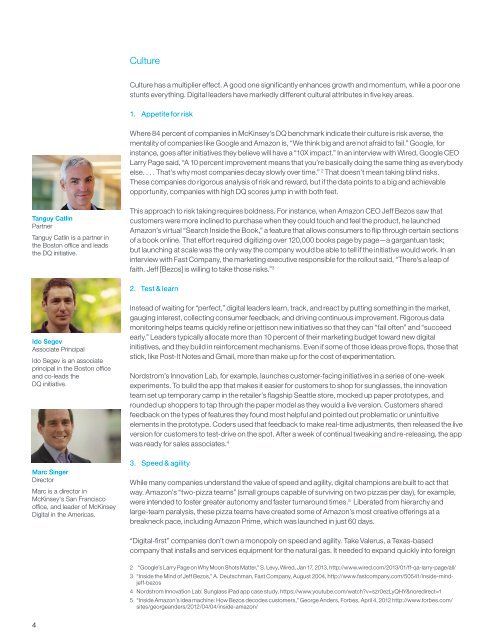Digital-Quotient
Digital-Quotient
Digital-Quotient
Create successful ePaper yourself
Turn your PDF publications into a flip-book with our unique Google optimized e-Paper software.
Culture<br />
Culture has a multiplier effect. A good one significantly enhances growth and momentum, while a poor one<br />
stunts everything. <strong>Digital</strong> leaders have markedly different cultural attributes in five key areas.<br />
1. Appetite for risk<br />
Where 84 percent of companies in McKinsey’s DQ benchmark indicate their culture is risk averse, the<br />
mentality of companies like Google and Amazon is, “We think big and are not afraid to fail.” Google, for<br />
instance, goes after initiatives they believe will have a “10X impact.” In an interview with Wired, Google CEO<br />
Larry Page said, “A 10 percent improvement means that you’re basically doing the same thing as everybody<br />
else. . . . That’s why most companies decay slowly over time.” 2 That doesn’t mean taking blind risks.<br />
These companies do rigorous analysis of risk and reward, but if the data points to a big and achievable<br />
opportunity, companies with high DQ scores jump in with both feet.<br />
Tanguy Catlin<br />
Partner<br />
Tanguy Catlin is a partner in<br />
the Boston office and leads<br />
the DQ initiative.<br />
This approach to risk taking requires boldness. For instance, when Amazon CEO Jeff Bezos saw that<br />
customers were more inclined to purchase when they could touch and feel the product, he launched<br />
Amazon’s virtual “Search Inside the Book,” a feature that allows consumers to flip through certain sections<br />
of a book online. That effort required digitizing over 120,000 books page by page—a gargantuan task;<br />
but launching at scale was the only way the company would be able to tell if the initiative would work. In an<br />
interview with Fast Company, the marketing executive responsible for the rollout said, “There’s a leap of<br />
faith. Jeff [Bezos] is willing to take those risks.” 3<br />
2. Test & learn<br />
Ido Segev<br />
Associate Principal<br />
Ido Segev is an associate<br />
principal in the Boston office<br />
and co-leads the<br />
DQ initiative.<br />
Marc Singer<br />
Director<br />
Marc is a director in<br />
McKinsey‘s San Francisco<br />
office, and leader of McKinsey<br />
<strong>Digital</strong> in the Americas.<br />
Instead of waiting for “perfect,” digital leaders learn, track, and react by putting something in the market,<br />
gauging interest, collecting consumer feedback, and driving continuous improvement. Rigorous data<br />
monitoring helps teams quickly refine or jettison new initiatives so that they can “fail often” and “succeed<br />
early.” Leaders typically allocate more than 10 percent of their marketing budget toward new digital<br />
initiatives, and they build in reinforcement mechanisms. Even if some of those ideas prove flops, those that<br />
stick, like Post-It Notes and Gmail, more than make up for the cost of experimentation.<br />
Nordstrom’s Innovation Lab, for example, launches customer-facing initiatives in a series of one-week<br />
experiments. To build the app that makes it easier for customers to shop for sunglasses, the innovation<br />
team set up temporary camp in the retailer’s flagship Seattle store, mocked up paper prototypes, and<br />
rounded up shoppers to tap through the paper model as they would a live version. Customers shared<br />
feedback on the types of features they found most helpful and pointed out problematic or unintuitive<br />
elements in the prototype. Coders used that feedback to make real-time adjustments, then released the live<br />
version for customers to test-drive on the spot. After a week of continual tweaking and re-releasing, the app<br />
was ready for sales associates. 4<br />
3. Speed & agility<br />
While many companies understand the value of speed and agility, digital champions are built to act that<br />
way. Amazon’s “two-pizza teams” (small groups capable of surviving on two pizzas per day), for example,<br />
were intended to foster greater autonomy and faster turnaround times. 5 Liberated from hierarchy and<br />
large-team paralysis, these pizza teams have created some of Amazon’s most creative offerings at a<br />
breakneck pace, including Amazon Prime, which was launched in just 60 days.<br />
“<strong>Digital</strong>-first” companies don’t own a monopoly on speed and agility. Take Valerus, a Texas-based<br />
company that installs and services equipment for the natural gas. It needed to expand quickly into foreign<br />
2 “Google’s Larry Page on Why Moon Shots Matter,” S. Levy, Wired, Jan 17, 2013, http://www.wired.com/2013/01/ff-qa-larry-page/all/<br />
3 “Inside the Mind of Jeff Bezos,” A. Deutschman, Fast Company, August 2004, http://www.fastcompany.com/50541/inside-mindjeff-bezos<br />
4 Nordstrom Innovation Lab: Sunglass iPad app case study, https://www.youtube.com/watchv=szr0ezLyQHY&noredirect=1<br />
5 “Inside Amazon’s idea machine: How Bezos decodes customers,” George Anders, Forbes, April 4, 2012 http://www.forbes.com/<br />
sites/georgeanders/2012/04/04/inside-amazon/<br />
4


